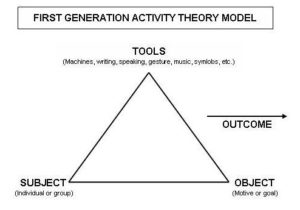The above chart represents Activity Theory as a visual foundation for rhetoric in all situations. Just like all frameworks of rhetoric, Activity Theory does not center on one single influence; instead, it must combine and create fluidity between all the working parts of its model and circumstances.
A subject is a person or a group engaged in an activity, such as a team of writers, or a writer and a team of experts working in a company. An object is held by the subject and motivates activity (creating a report, a presentation, etc), giving the subject a specific direction to move in. The direction that the subject takes is prone to the influences of the other pieces of the Activity Theory Model. These influences are both external and internal.
In any type of technical writing or communication, the audience/community is one of the most important aspects. Tailoring your writing towards your audience remains essential to your outcome, and this depends on the writer (the subject) properly examining and interacting with their audience. The rules that influence the writing are part of the corporate culture of the group that one is working with or within.
Each company has certain standards, rules, and expectations that they expect a communicator to follow when producing for their business. The allocation of work also depends on the structure of the company and the structure of the subject group. Working as an individual may be more comfortable, but there is still a sense of structure in any company.
Levels of authority exist in the corporate community and must be recognized and respected in order to produce an effective document. “Organizational hierarchies do create separate cultures with differential access to power, but at each level…[you can observe] a degree of agency in granting and withholding cooperation” (Clark, 2004). Hopefully, when working with other subjects, you don’t run into roadblocks such as the withholding of cooperation, but knowing that it exists is an equally important part of the model.
The subject creates the tools at the apex of the triangle through the interaction with all of the other parts of this model. These tools are then applied in constructing the object (which has been motivating the subject the whole time) and reaching the ideal outcome.
Although this model is triangular, the activity model is also a cyclical theory, in which each achievement propels a new set of questions that can result in learning (Wegner, 2004, p. 412).

